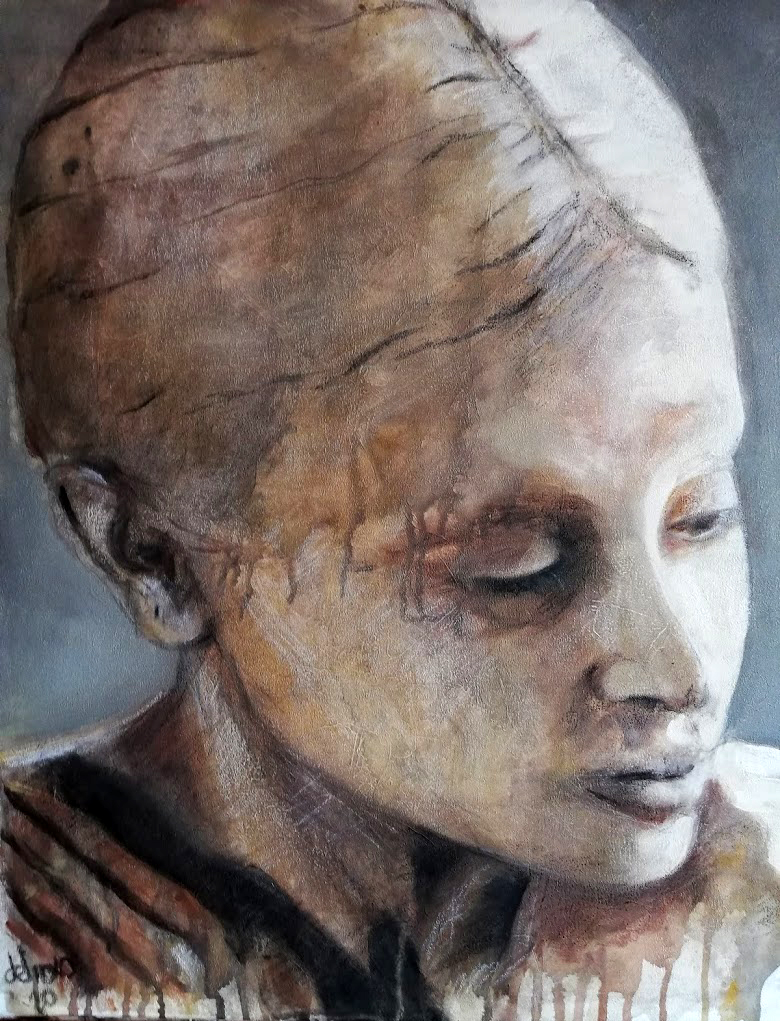
Los siete pecados capitales (La Pereza) – Parte 6 * The seven deadly sins (Sloth) – Part 6
**For the English version, please scroll down the page**
El monje Evegrio hablaba de ella como la Acedia, pero viene a ser lo mismo, el perezoso es aquel que no se ocupa diligentemente de sus deberes. Veamos la descripción que de tal individuo nos da el monje asceta:
Cuando lee, el acedioso bosteza mucho, se deja llevar fácilmente por el sueño, se refriega los ojos, se estira y, quitando la mirada del libro, la fija en la pared y, vuelto de nuevo a leer un poco, repitiendo el final de la palabra se fatiga inútilmente, cuenta las páginas, calcula los párrafos, desprecia las letras y los ornamentos y finalmente, cerrando el libro, lo pone debajo de la cabeza y cae en un sueño no muy profundo, y luego, poco después, el hambre le despierta el alma con sus preocupaciones.
Sustituye libro por televisión, y párrafo por anuncio, y tenemos al perezoso o perezosa de hoy día. Quién no se siente identificado. Quién no reconoce la pereza en sí mismo. Quién no lo ve como el vicio más perdonable de todos cuantos estamos abordando. La mayoría de las personas a las que he preguntado, han optado porque este pecado sea su número uno. Y prácticamente la totalidad coincide en que es el más venial de todos ellos. Hay quien dice incluso (amigo Carlos) que gracias a la pereza se evitan otros pecados mayores. Y no le falta razón.
Cómo veo yo la pereza. Pues como miembro de pleno derecho de la cofradía de la diligencia, no me reconozco en ella, y antes de tener la imagen en la cabeza sabía que tenía que ser gris y marrón, sombría. Para reforzar mi convencimiento recurrí una vez más a Eva Heller, que no se corta un pelo al afirmar que el marrón es precisamente el color de la pereza y de la necedad. ¿Qué color caracterizaría mejor a los apáticos que el marrón? Pues si lo combinamos con el gris, que es un color apático y sin fuerza, tenemos el acorde perfecto para definir la pereza cromáticamente.
Me faltaban dos cosas todavía: seleccionar la imagen y la técnica. La segunda surgió de forma casual, mientras estaba empapelando una pared de mi estudio. El papel imitaba ladrillos blancos sobre un fondo de cemento gris, y me pareció ideal para pegarlo sobre el lienzo y utilizarlo de soporte y fondo para la escena. Esta casual elección definió asimismo la imagen a representar entre varias que tenía preseleccionadas. Si bien es cierto que el proceso posterior me llevó a un fondo gris opaco en el que no se aprecia el ladrillo, la técnica utilizada, de aguada de acrílico hace que en determinadas zonas del lienzo se perciba parte de esa textura que, yo creo, resulta muy interesante y apropiada. Los churretes y las manchas ayudan a simular un cuarteado del rostro, un envejecimiento de la piel que recuerda a una estatua antigua que languidece (de pereza) en un jardín abandonado.
** English Version**
The monk Evagrius Ponticus used the word “Acedia” to describe this vice. He says that the sluggard is the person who does not diligently attend to his duties. Let see the description of such an individual according to the ascetic monk:
When reading, the sluggard often yawns and gets carried away by sleep. He rubs his eyes, stretches and his sight comes to rest in the walls, he returns to the book again, reads a little further, repeats the last word and gets easily tired, he counts the pages, calculates the paragraphs, despises the letters and the ornaments and finally closes the book, sets it under his head and falls into a restless sleep waking up soon after with his soul full of concerns.
We only need to replace the book with the tv and the paragraph with the tv commercials and we shall find out today’s sluggard. We can easily identify ourselves with this vice, we can easily find laziness in ourselves, and we can also easily forgive it. Most of the people I have talked to have selected sloth as their number one vice. And almost all of them agree on the fact that it is the most forgivable one. There is even one friend who claims that thanks to the sloth we can avoid more serious vices. He might be right.
How do I personally see sloth. As a full member of the Diligence Confraternity I do not identify myself with this vice. The image I had in mind from the very beginning was dull, grey and brown. In order to reinforce my idea I turned once again to Eva Heller who boldly declares that brown is precisely the shade for laziness and folly. What colour would better define the apathy? If we combine it with grey, an apathic and weak colour, we have the perfect combination to define the sloth from a chromatic point of view.
I was still missing two things: the image and the technique. The second one arose unexpectedly when I was wallpapering my studio. The wallpaper imitated a white and grey brick structure and it struck me as optimal to use it as a background for my image, pasting it to the canvas. This accidental choice also helped me defining the image from the ones I had already pre-selected. Even if the later process brought it to an opaque grey background where the brick is hardly recognizable, the technique I used of watered layers of acrylic paint made it possible to recognize the texture in some parts of the canvas. The patches and stains help imitate the effect of cracking in the face, an ageing of the skin that reminds of an ancient statue languishing (in sloth) in a neglected garden.
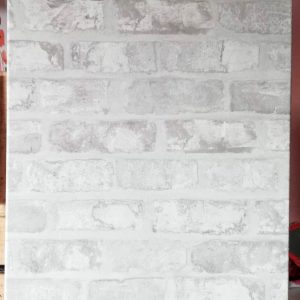
Partimos de un lienzo cubierto con papel de empapelar / We set out from a canvas covered with wall paper<br />
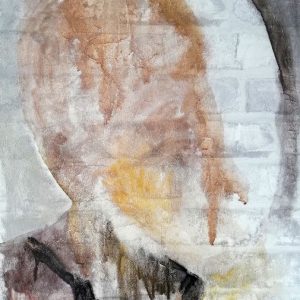
Primera fase de manchas aplicando acrílicos y tintas líquidas /First stage, patching with acrylic and ink<br />
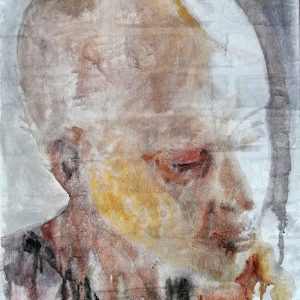
Una vez seco, repetimos manchas para ir consiguiendo texturas interesantes /After drying we repeate the process to obtain interesting textures.</p> <p>
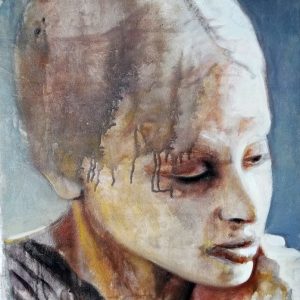
Aquí ya hemos ido definiendo las zonas de luz antes de rematarlo / I have already defined the light areas here before the work enters in its final stage.<br />
Continúa en/Follow to: Los Siete Pecados Capitales – Parte 7




